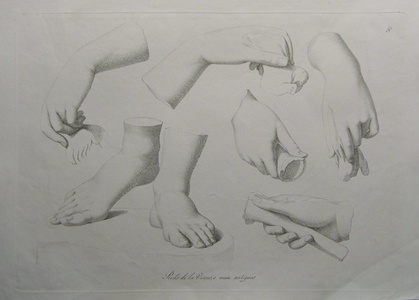| Method | Copper engraving |
| Artist | Giovanni Volpato and Raffaello Morghen |
| Published | Rome, Pagliarini, 1786. |
| Dimensions | Plate 365 x 505 mm, Sheet 440 x 575 mm. |
| Notes |
From Volpato and Morghen's Principi del disegno. Tratti dall piu eccellenti statue antiche per il giovanni che vogliono incamminarsi nello studio delle belle arti. Consisting of 36 plates, Principi del disegno... was a drawing manual depicitng six famous classical sculptures from various angles, which were then to be copied by students. Printed in Italian and French. Giovanni Trevisan Volpato (1740 - 1803) was an Italian printmaker, publisher and dealer in antiquities. Volpato was born in Bassano, and received his first training from his mother, an embroiderer, before studying under Giovanni Antonio Remondini. In 1762, he travelled to Venice, wherein he worked with Joseph Wagner and Francesco Bartolozzi. Nine years later Volpato relocated to Rome. Whilst in the capital, he founded a school of engraving and produced a series of plates after the frescoes of the Raphael Rooms and Loggias in the Vatican. It is from this series that his 'School of Athens' print derives. Volpato also engraved a set of plates after Annibale Caracci's decorations in the Palazzo Farnese, and in 1785, he founded a factory which created biscuit porcelain replicas of famous Greco-Roman statues in order to satiate the demand for antique art during the Neoclassical period. Raffaello Sanzio Morghen (1758 – 1833) was an Italian engraver. Morghen was born in Naples, apparently to a German family of engravers. He received his earliest training from his father, then became a pupil of Giovanni Volpato. He assisted Volpato in engraving the frescoes of the Raphael Rooms. Morghen married Volpato's daughter, and, after being invited to engrave the masterpieces of the Florentine Gallery, he moved to Florence with his wife in 1782. Becoming extremely reputable throughout Florence, Morghen was recommended to the Grand Duke to engrave Da Vinci's Last Supper. Due to the state of the original painting, and consequently the poor drawing produced for Morghen, the engraving proved to be somewhat of a failure. However, Morghen's fame swiftly spread across Europe. In 1803, the Institute of France elected him an associate, and in 1812, Napoleon invited him to Paris. |
| Framing | unmounted |
| Price | £100.00 |
| Stock ID | 34437 |

